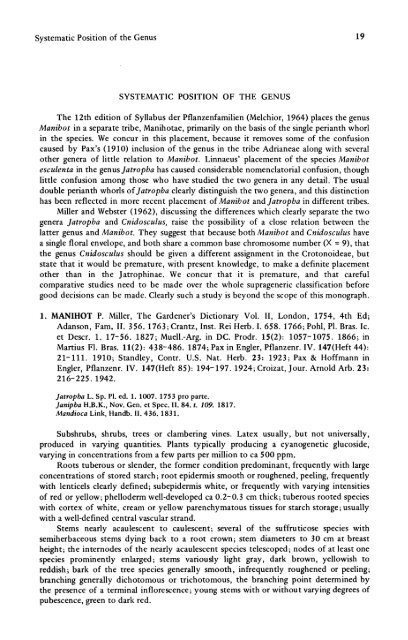Manihot Manihotoides (Euphorbiaceae) - CNCFlora
Manihot Manihotoides (Euphorbiaceae) - CNCFlora
Manihot Manihotoides (Euphorbiaceae) - CNCFlora
Create successful ePaper yourself
Turn your PDF publications into a flip-book with our unique Google optimized e-Paper software.
Systematic Position of the Genus 19<br />
SYSTEMATIC POSITION OF THE GENUS<br />
The 12th edition of Syllabus der Pflanzenfamilien (Melchior, 1964) places the genus<br />
<strong>Manihot</strong> in a separate tribe, <strong>Manihot</strong>ae, primarily on the basis of the single perianth whorl<br />
in the species. We concur in this placement, because it removes some of the confusion<br />
caused by Pax's (1910) inclusion of the genus in the tribe Adrianeae along with several<br />
other genera of little relation to <strong>Manihot</strong>. Linnaeus' placement of the species <strong>Manihot</strong><br />
esculenta in the genus Jatropha has caused considerable nomenclatorial confusion, though<br />
little confusion among those who have studied the two genera in any detail. The usual<br />
double perianth whorls of Jatropha clearly distinguish the two genera, and this distinction<br />
has been reflected in more recent placement of <strong>Manihot</strong> and Jatropha in different tribes.<br />
Miller and Webster (1962), discussing the differences which clearly separate the two<br />
genera Jatropha and Cnidosculus, raise the possibility of a close relation between the<br />
latter genus and <strong>Manihot</strong>. They suggest that because both <strong>Manihot</strong> and Cnidosculus have<br />
a single floral envelope, and both share a common base chromosome number (X = 9), that<br />
the genus Cnidosculus should be given a different assignment in the Crotonoideae, but<br />
state that it would be premature, with present knowledge, to make a definite placement<br />
other than in the Jatrophinae. We concur that it is premature, and that careful<br />
comparative studies need to be made over the whole suprageneric classification before<br />
good decisions can be made. Clearly such a study is beyond the scope of this monograph.<br />
1. MANIHOT P. Miller, The Gardener's Dictionary Vol. II, London, 1754, 4th Ed;<br />
Adanson, Fam. II. 356. 1763; Crantz, Inst. Rei Herb. I. 658. 1766; Pohl, P1. Bras. Ic.<br />
et Descr. 1. 17-56. 1827; Muell.-Arg. in DC. Prodr. 15(2): 1057-1075. 1866; in<br />
Martius Fl. Bras. 11(2): 438-486. 1874; Pax in Engler, Pflanzenr. IV. 147(Heft 44):<br />
21-111. 1910; Standley, Contr. U.S. Nat. Herb. 23: 1923; Pax & Hoffmann in<br />
Engler, Pflanzenr. IV. 147(Heft 85): 194-197. 1924; Croizat, Jour. Arnold Arb. 23:<br />
216-225. 1942.<br />
Jatropha L. Sp. PI. ed. 1. 1007. 1753 pro parte.<br />
Janipha H.B.K., Nov. Gen. et Spec. II. 84. t. 109. 1817.<br />
Mandioca Link, Handb. II. 436. 1831.<br />
Subshrubs, shrubs, trees or clambering vines. Latex usually, but not universally,<br />
produced in varying quantities. Plants typically producing a cyanogenetic glucoside,<br />
varying in concentrations from a few parts per million to ca 500 ppm.<br />
Roots tuberous or slender, the former condition predominant, frequently with large<br />
concentrations of stored starch; root epidermis smooth or roughened, peeling, frequently<br />
with lenticels clearly defined; subepidermis white, or frequently with varying intensities<br />
of red or yellow; phelloderm well-developed ca 0.2-0.3 cm thick; tuberous rooted species<br />
with cortex of white, cream or yellow parenchymatous tissues for starch storage; usually<br />
with a well-defined central vascular strand.<br />
Stems nearly acaulescent to caulescent; several of the suffruticose species with<br />
semiherbaceous stems dying back to a root crown; stem diameters to 30 cm at breast<br />
height; the internodes of the nearly acaulescent species telescoped; nodes of at least one<br />
species prominently enlarged; stems variously light gray, dark brown, yellowish to<br />
reddish; bark of the tree species generally smooth, infrequently roughened or peeling;<br />
branching generally dichotomous or trichotomous, the branching point determined by<br />
the presence of a terminal inflorescence; young stems with or without varying degrees of<br />
pubescence, green to dark red.

















